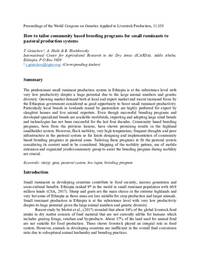How to tailor community based breeding programs for small ruminants to pastoral production systems

Authors:
The predominant small ruminant production system in Ethiopia is at the subsistence level with very low productivity despite a huge potential due to the large animal numbers and genetic diversity. Growing market demand both at local and export market and recent increased focus by the Ethiopian government considered as good opportunity to boost small ruminant productivity. Particularly local breeds in lowlands reared by pastoralists are highly preferred for export by slaughter houses and live animal exporters. Even though successful breeding programs and developed specialized breeds are available worldwide, importing and adopting large sized breeds and technologies has not been successful for the last four decades. Community based breeding programs, born from the previous lessons, have shown promising results in the highland smallholder system. However, flock mobility, very high temperature, frequent droughts and poor infrastructure in the pastoral system so far limits designing and implementation of community based breeding programs in pastoral areas. Tailoring these programs to fit the pastoral system considering its context need to be considered. Mapping of the mobility pattern, use of mobile extension and organized youth/community group to assist the breeding program during mobility are crucial. Keywords: sheep, goat, pastoral system, low input, breeding program.
